Here is the exact same watercolor paper I used to create the color mixing chart in this article.
About Color Mixer Tool
Dopely’s online color mixer tool helps you to achieve your desired color by combining up to 15 colors with adjustment of percentage, hue, saturation, and brightness. Then you can save, share and export your final color in various formats. To have more control and vision, use the full screen mode. This tool will help anybody that is struggling with colors, from who is going to paint their wall to artists, to stop wasting color. This is a color paint mixing stimulator that will show you the final color, resulting by adding different quantities of different colors up together.
If there were no primary colors to mix with each other, there would be no color combination. In this case, we can boldly say that the colors were not as diverse today. Mixing primary colors with each other creates secondary, tertiary colors and more diverse color combinations, which includes the creation of more new colors. So that today there are 10,000,000 colors in the world, of which only 7,000,000 are visible to the human eye.
In addition to physical color mixing, there are two main types of color mixing. One is additive (like just with physical colors and paint tubes) and the other is subtractive (like what happens in sunlight, which consists of 7 colors but it is white). In both types, you can have any color by only mixing three primary colors. But for you to be faster, in dopely color combining tool, you can select any color with a handy color picker, as your primary material.
Colors Mixing
The combination of physical colors is one of those things that you can master by learning the color wheel, and that teaching this mixing to children is also more understandable.
There are three primary colors: blue, red, and yellow. From the equal mixture of each of the primary colors,secondary colors are created: green, orange, and purple. Then, by mixing the secondary colors,third colors (triatry colors)are created: Vermilion, Magenta, Violet, Teal, Amber, Chartreuse. And all the other 64 million colors can be created by using only primary colors.
Additive Mixing (RGB Color Mixer)
If two beams of light are placed on top of each other, their colors are mixed additively. In additive mixing, there are three main colors of light: red, green, and blue. With an equal mixture of each of these primary light colors, white is obtained.
In this way, yellow is obtained by mixing red and green light. With a mixture of green and blue, cyan is obtained. Finally, magenta is obtained by mixing blue and red. All three are secondary colors of light.
One of the most common uses of this mixture is in TVs, computer monitors, and smart phone monitors to produce a wide range of colors.
Why color mixing charts are helpful
When creating color mixing charts, you get to mix every color with every other color. Doing this exercise allows you to mix some colors that you would otherwise never think of mixing together. So, it is a great way to discover some great new color mixtures and understand how colors work together!
Become more confident mixing colors
Creating a color chart can also help to boost your confidence when it comes to mixing colors for painting. Very often one might know what color one wants but has no idea how to mix it. However if you have already gone through the process of mixing all of your colors with each other. Then you will have a much better idea how to get the colors you need, with the colors you have.
How to make a color mixing chart
To start making a color chart you will need:
- A ruler
- a sheet of paper (or canvas if doing an oil paint color chart)
- All the colors you wish to use for your color chart
You can make color mixing charts with as few or as many colors as you would like. Keep in mind though, if you want to create a color chart mixing 24 colors… You will be mixing 576 squares! Yikes! The color chart directly below has just 7 colors, as it is a great starting point, with colors I use often.

Paper I used for painting color mixing chart
To make the above chart I grabbed a sheet of 9 x 12 watercolor paper. As I made this color chart with watercolor paints. You can also use watercolor paper if you are painting color charts with acrylic or gouache paint. You could technically use watercolor paper for an oil paint color mixing chart as well. Though it would not be archival. If you want your oil color mixing chart to last, use a sheet of primed canvas or primed heavyweight paper.
Begin by drawing the squares that will be used for the color chart mixing guide
Grab your ruler and measure out your color chart so that you have one inch square of space for each area. I also left one inch of space from the margin for the side and upper margin where I labeled the color names. I made each of my squares one inch but you can make the squares as small or big as you like!
Write the name of each color on the margin of the color mixing chart
Label each of the squares on the left side and top margin. You will be labeling the same color on each side in the same order- as can be seen in the sample image below.
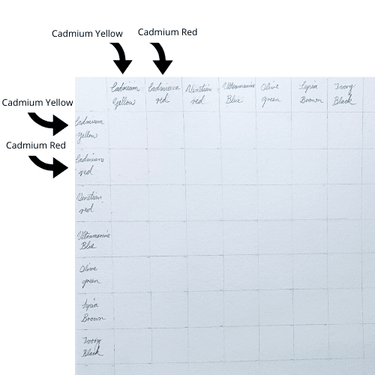
Add reference spots of color
Next, paint a spot of color next to each respective color name as seen in the image below. This serves as a reminder of what the color looks like next to the color name.
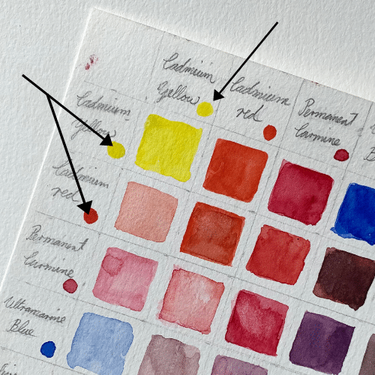
Begin filling in the boxes of the color chart
We begin by painting color chart boxes with their respective colors in in a diagonal line. So, the first square is filled with cadmium yellow, the square next to it is cadmium red and so on and so forth…
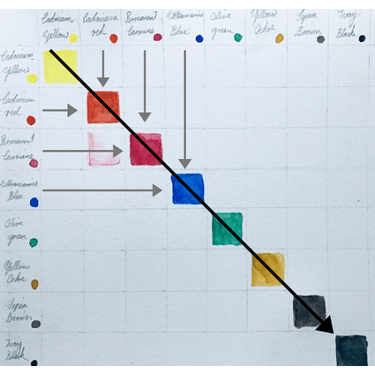
Start mixing color chart colors!
Now, comes the fun part of creating a color chart. You get to start actually mixing colors! When you are at the Cadmium red spot on the upper margin and move down to Ultramarine blue you will then mix cadmium red and ultramarine blue together.
You will do this for every single one of the colors. You will notice however that you create two sets of each color mixture. So, for each time that you mix cadmium + Ultramarine blue, you mix it a second time on the other side of the diagonal line.
If you haven’t already – grab my FREE Color Mixing Guide for helpful color mixing instructions and techniques!
Create the color mix with 50% of each color
If you are wondering how much of each color to put in a mixture, you will always do 50% of each. So, when you mix ultramarine blue + cadmium yellow you will mix 50% of cadmium yellow + 50% of ultramarine blue. This way it is an equal color mixture.
A dark area and light area on your color chart
Because it would not make much sense to mix the same color in the same manner twice. You will first create a color mixture that is light and then one that is darker the second time. See the image below and how the left side of the color chart is lighter and the right side is darker.
Putting down the base colors in 3 directions – each with a different tonal value
In addition, you will be putting down your base colors three times. Once horizontally along the first top row of squares. Once vertically along the first left row of squares and then once diagonally down and across the middle. For clarification, when i say base colors, I mean the colors you are using that you wrote the names of.
You will put down these colors in three different values. On the far left margin the base colors will be lightest in value. Along the middle, diagonal line they will be a medium value. Then along the upper margin the colors will be the darkest value. This portion of the color chart creation will really help you in understanding tonal values and how to create them.
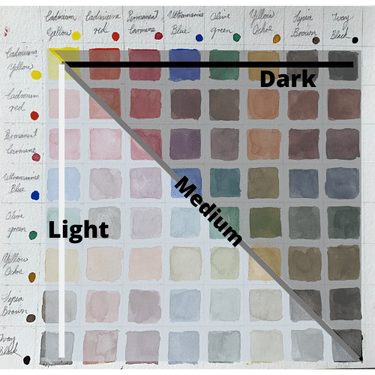
A note about different paint mediums
The color mixing chart used in this article is made with watercolor. However, the principles are the same no matter what medium you use. Whether it is acrylic, oil paint, gouache or something else!
When mixing your lighter colors with watercolor you will use less pigment and more water. However, when mixing a color chart with oil paint, acrylic or gouache you will use white to lighten your colors.
Last but never least… Mixing all of the colors for your color mixing chart!
Now all that is left, is to go ahead and mix all of the colors for your color chart! It can take a little bit of time to mix all of the colors… However, the learning is in the process of mixing colors and making the color chart! It can be a fun process of discovery, as you learn what color is made when each color is mixed together.
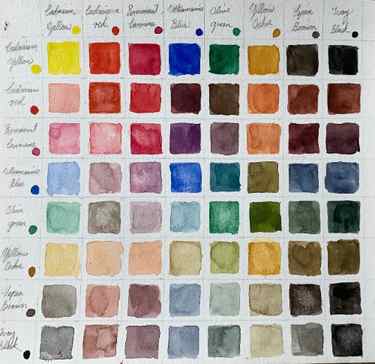
How to use your color chart
Now that you have a beautiful rainbow looking color mixing chart how do you use it?? Not only do you learn quite a bit while making a color chart. It can also serve as a useful reference and color mixing guide for when you work on your own projects. For example, if you are ever stumped and unsure how to get a particular color. Take a look at your color mixing chart as a reference, to see which colors you need to mix.
Also, you can add to your color chart mixing in new colors as you purchase them. It is a great way of getting to know your new color. As well as what kinds and shades of colors that can be mixed with it!
Mixing Colors: Create and Name Your Own Colors
Mixing colors is one of the most classic art activities for kids and is always a hit. We were inspired by Herve Tullet’s new book, Mix It Up!, to create our own colors by mixing paints. We saved our favorite colors on our Personal Paint Palette free printable and even named the colors ourselves!
I was provided this book for free, but of course all opinions are my own. This post contains affiliate links.
Follow our Art for Kids Pinterest board!
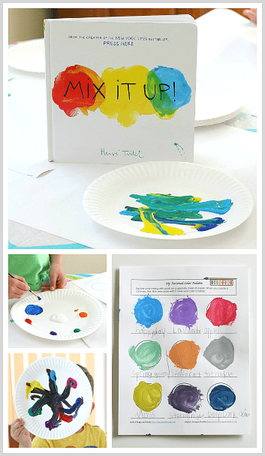
*This post was originally posted on November 17, 2014 and has since been updated.
The Preschool Book Club is back this week with creative activities for kids inspired by Herve Tullet’s newest children’s book, Mix It Up! Every other week we’ll all be sharing some fun activities for kids based on the book of the week. (Be sure to check out all my activities for kids inspired by children’s books!)
Mixing Colors Activity for Kids Inspired by Mix It Up!
A few months back we shared some activities for kids based on the popular children’s book, Press Here by Herve Tullet. (If you missed them, be sure to check them out: Press Here Tossing Math Game, Press Here Playdough Activity, and our Press Here Necklace Craft.) The author just recently release a new book that we absolutely love- Mix It Up!
Just like the book, Press Here, kids are active participants in the story- using their imaginations along with their hands to splatter and mix colors all throughout the book. Children learn the basics of color mixing as they read this hands-on book!
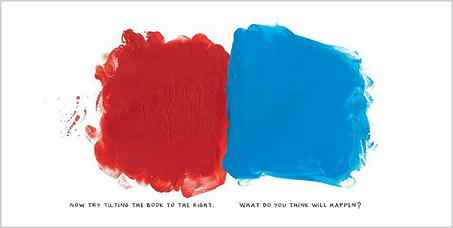
Mix It Up! inspired us to get out our paints and get mixing! We created all kinds of colors and even named them ourselves using the free printable.
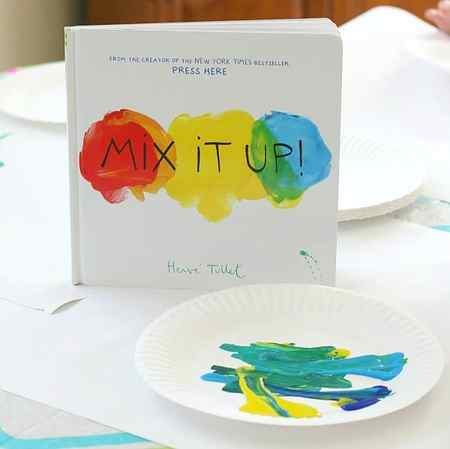
Materials for Mixing Colors Activity
- Tempera paint
- Paintbrushes
- Paper plates
- Optional: Free Paint Palette Printable and pencil
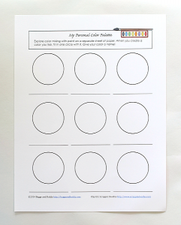
Directions for Mixing Colors Activity
Start by setting up your workspace. You want to have plenty of room for kids to explore paint mixing. We covered our kitchen table with our art mat and some large sheets of white paper. We placed all our materials right on the table so we were ready to go!
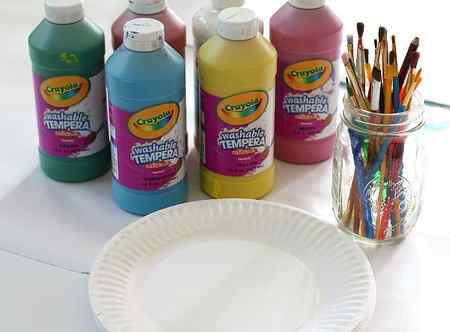
We started out our activity by following right along with the story- mixing the colors in the order they were mixed in the book.
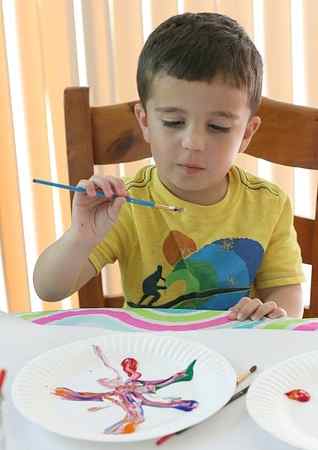
We created green, purple and orange using the three primary colors. We explored what happens to colors when you add white or black to them and even what happens when you mix black and white together!
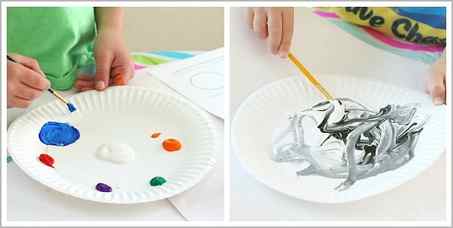
As the kids mixed colors, they’d save favorites they created on their free printable paint palette by painting in the circles.
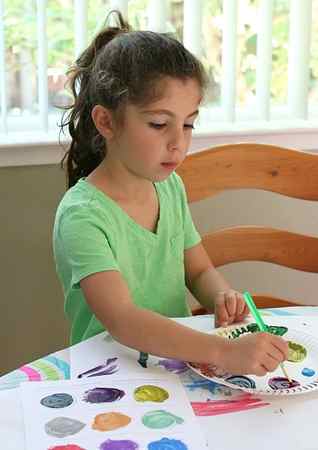
After we had tried out all the color mixing demonstrated in the book, I let the kids mix all on their own.
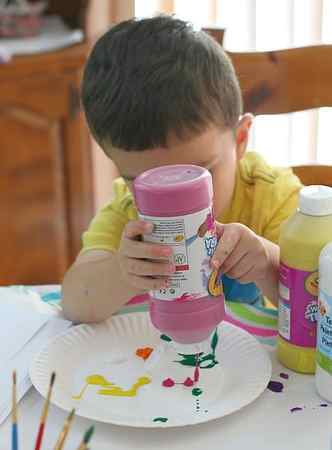
Lucy began to paint pictures. She’d mix colors on her paper plate until she got just the right one to add to her artwork!
Theo loved creating designs right on his plate as he mixed colors!
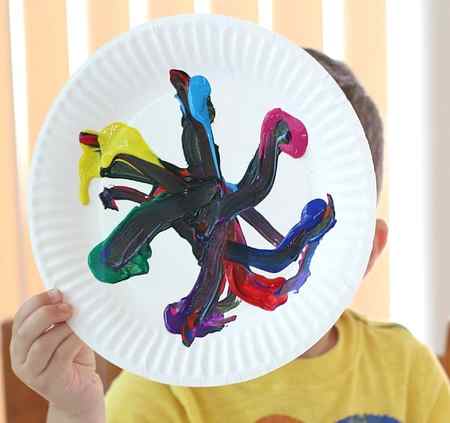
After cleaning up, we sat down and named the colors we had created. I just love the names they came up with- “Happy Day”, “Stormy Night”, and “Dolphin” were a few of my favorites!
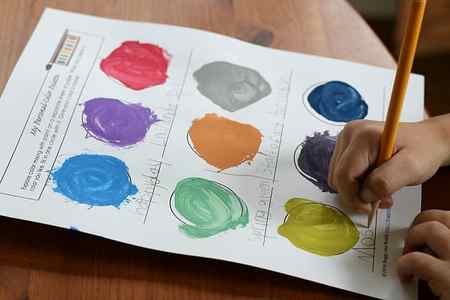
This color mixing activity was an absolute hit. Both Theo and Lucy have already mentioned more than once they want to do it again!
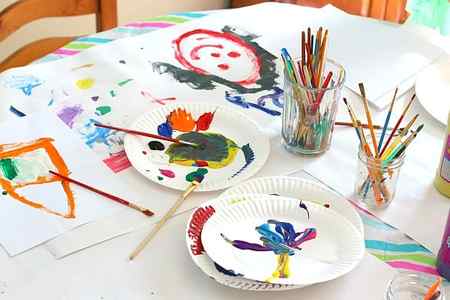
More Mix It Up! Activities
Be sure to check out all the creative Mix It Up! activities created by the other members of The Preschool Book Club Series!
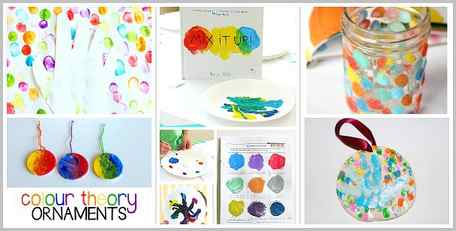
Fun Fingerprint Art from Frogs and Snails and Puppy Dog Tails





